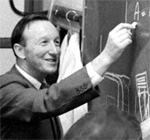What invention is all about
Francis Farley, a British physicist who joined CERN in 1957, put together the first experiment on the anomalous magnetic moment of the muon and has since taken part in all the experiments relating to this phenomenon.
 “One day I received a telegram from the magazine Scientific American asking me to send details of my experiment for an article about the Moon. As my experiment had nothing to do with the Moon, I didn’t reply. A few weeks later, however, they wrote to me again. It was then that I realised that there had been a typing mistake. They were actually asking me for information about the muon, not the Moon. At first I had thought that there was no connection between the two but I was wrong.
“One day I received a telegram from the magazine Scientific American asking me to send details of my experiment for an article about the Moon. As my experiment had nothing to do with the Moon, I didn’t reply. A few weeks later, however, they wrote to me again. It was then that I realised that there had been a typing mistake. They were actually asking me for information about the muon, not the Moon. At first I had thought that there was no connection between the two but I was wrong.
One of the great mysteries at the time of Isaac Newton was understanding how the Moon was affected by the Earth or, in other words, how gravity worked. It’s the same thing with electromagnetics. What happens between two charged particles that are attracted to each other or repel each other? This is what the theory of quantum electrodynamics explains. It holds that the electron is surrounded by a cloud of ‘virtual’ photons that are emitted and reabsorbed. If another electron enters the cloud, photons are exchanged.
Gravitation is explained by a similar theory. Virtual gravitons are thought to be exchanged between the Sun, the Earth, and the Moon. In quantum electrodynamics, the virtual photons alter the magnetic moment of the particle. If we can detect this variation, we have direct evidence that these virtual photons exist and this was the aim of our experiment.
The first article we published in 1961 took the world by storm because it was the first time that the anomalous magnetic moment of the muon had been measured. As a result, the experiment served as a launching pad for the group’s members to go on to do other things. I was the only one who stayed behind. I went on to work on the second experiment, where I met Emilio Picasso, with whom I got on tremendously well. We got a new team together and achieved much more precise measurements than with the first experiment. As our results did not tie in with theory, we started to think of ideas for a third experiment. We achieved such precision that we decided not to go any further.
The science I have experienced has been all about imagining and creating pioneering devices and observing entirely new phenomena, some of which have possibly never even been predicted by theory. That’s what invention is all about and it’s something quite extraordinary. CERN was marvellous for two reasons: it gave young people like me the opportunity to forge ahead in a new field and the chance to develop in an international environment.”

